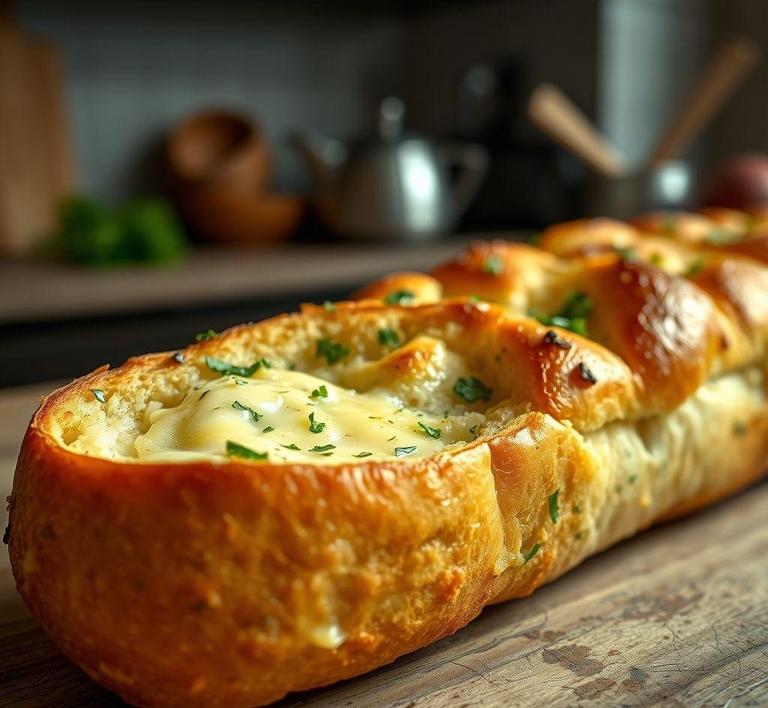If you’ve ever made a batch of delicious garlic bread and found yourself with leftovers, you might be wondering if it’s possible to refreeze cooked garlic bread without losing its flavor or texture. The good news is, yes, you can refreeze garlic bread! However, there are a few key steps to take to make sure that it stays as fresh and tasty as the first time around. From how to properly store it to the best reheating methods, this guide will walk you through everything you need to know to enjoy your garlic bread just like it was freshly baked, even after it’s been frozen!
Can You Refreeze Cooked Garlic Bread?

Refreezing cooked garlic bread is a common question that often arises when people have leftovers or have made too much to consume in one sitting. The general rule with most foods is that refreezing can alter their texture, taste, and overall quality, but garlic bread presents a slightly more complex case.
Garlic bread, which is typically made by slathering butter and garlic on slices of bread (often French or Italian bread) and baking it to a golden, crispy finish, can indeed be refrozen. However, there are certain considerations to take into account to ensure the best possible outcome.
The key factor to consider is how garlic bread is prepared. If the bread has been baked with a lot of butter or oil, it may maintain some moisture and flavor even after being frozen, making it less prone to drying out compared to a bread that has been baked with a drier recipe. However, garlic bread is particularly susceptible to texture changes after freezing because of its crisp outer layer, which could become soggy when reheated.
How To Refreeze Cooked Garlic Bread?
Refreezing garlic bread requires a careful approach to ensure that its taste and texture remain as close to the original as possible. Here’s a detailed guide on how to do it properly:
- Cool Down Completely: The first step is to allow the cooked garlic bread to cool down completely before freezing. If you try to freeze it while it’s still warm, condensation can form inside the packaging, leading to soggy bread when reheated.
- Wrap It Well: Proper wrapping is essential to maintaining the quality of your garlic bread during freezing. Use plastic wrap or aluminum foil to cover the bread thoroughly. For an extra layer of protection, you can place the wrapped bread inside a resealable plastic freezer bag or airtight container. This helps protect the bread from freezer burn, which can cause a loss of flavor and texture.
- Freeze Immediately: Once wrapped, place the garlic bread in the freezer. It’s best to freeze it as soon as possible to maintain the freshness of the bread. Try not to leave it in the freezer for too long before using it.
- Label and Date: As with all frozen foods, it’s a good practice to label the garlic bread with the date you froze it. This helps you keep track of how long it’s been stored and ensures that it’s consumed within a reasonable time frame.
- Reheating Process: When you’re ready to refreeze and eat the garlic bread, there’s a proper method to ensure it reheats well. Avoid microwaving directly if you want to maintain the crispy texture; instead, place the garlic bread in the oven at a moderate temperature (350°F or 175°C) for about 10-15 minutes. This will help bring back some of the crispiness that is often lost when garlic bread is frozen.
Quality Impact
While you can refreeze cooked garlic bread, it’s important to note that the process will likely impact its quality. The texture of garlic bread is its main charm-crispy on the outside, soft and flavorful on the inside. Refreezing can cause some negative changes:
- Texture Loss: The most noticeable change will be in the bread’s texture. The outer crust may lose its crispness and turn soft or even soggy after refreezing. This happens because the moisture in the bread, once frozen, may become trapped inside during the reheating process, making it less appealing than when freshly baked.
- Flavor Deterioration: Freezing and then reheating garlic bread can also cause the flavors of the garlic and butter to diminish slightly. Garlic has a strong aroma and flavor, but it can become more muted after freezing and refreezing. The bread’s flavor might not be as bold as when it was freshly made.
- Dryness or Toughness: If garlic bread is overexposed to air during the freezing process (due to improper wrapping), it can dry out. The bread might also become tough or chewy in the center, which is far from ideal for a dish that’s meant to be light and airy.
- Moisture Imbalance: If the garlic bread was made with a lot of butter or oil, you may notice some greasy residue when reheating. While this doesn’t necessarily make it inedible, it can alter the way the bread feels in your mouth, making it slightly heavy rather than light and crisp.
Refreezing cooked garlic bread is definitely possible, but it’s not without consequences. The key factors to consider are the bread’s texture and flavor, both of which can be compromised by freezing and reheating. To ensure that your garlic bread tastes as good as possible after being refrozen, it’s essential to cool it down completely before wrapping it properly for freezing. Additionally, when reheating, use an oven rather than a microwave to maintain the crispy texture.
While refreezing garlic bread isn’t the ideal way to preserve its original quality, if done correctly, it can still provide a satisfying snack or side dish. However, keep in mind that the longer the bread stays frozen, the more the quality may diminish. For the best experience, try to consume your garlic bread within a few weeks of freezing.
Is It Safe To Refreeze Cooked Garlic Bread?
Refreezing cooked garlic bread is a common practice for many who enjoy the convenience of preserving leftover bread for future meals. However, whether or not it is safe to do so depends on several factors, including how the bread was initially cooked, stored, and handled.
Garlic bread, typically made from a base of crusty bread, butter, garlic, and herbs, tends to have a high moisture content due to the butter and oil. These ingredients can affect both the texture and safety of the bread when refrozen. As a general rule, it is safe to refreeze cooked garlic bread as long as the bread was cooked properly, cooled to room temperature, and stored correctly before being frozen.
The primary concern in refreezing cooked garlic bread lies in the quality and texture of the bread after it is reheated. Freezing and thawing cause ice crystals to form, which can break down the bread’s structure. This results in a soggy or stale texture when reheated. While refreezing does not make the garlic bread unsafe to eat, it can degrade the overall eating experience. That said, as long as there are no signs of spoilage or bacterial growth, it’s safe to eat.
Signs That Cooked Garlic Bread Should Not Be Refrozen
Before deciding to refreeze cooked garlic bread, it’s essential to ensure that it hasn’t already deteriorated in some way. Here are the key signs that cooked garlic bread should not be refrozen:
- Off Smell: One of the most apparent signs that your garlic bread has gone bad is a sour or rancid odor. Garlic bread contains butter and oil, which can spoil if not stored properly. If the bread smells off in any way, it is best to discard it, as refreezing would only preserve the deterioration.
- Visible Mold: Mold growth is another obvious sign that the bread should not be consumed or refrozen. Mold can develop quickly on moist foods, especially those with perishable ingredients like butter and garlic. Mold spores multiply rapidly in environments that are not adequately cold or sealed.
- Changes in Texture: If the garlic bread has been sitting out for too long at room temperature or has undergone multiple freezing and thawing cycles, it may become overly soggy or mushy. While this might be fine for a quick snack, the texture can be irreparably damaged if refrozen, resulting in a mushy, unappetizing end product.
- Freezer Burn: If the bread has been improperly wrapped or stored in the freezer for an extended period, it may develop freezer burn. This is when the bread appears to have dry, grayish spots that indicate dehydration and loss of moisture. Freezer burn doesn’t pose a health risk but can lead to a tough and dry texture that won’t improve after refreezing.
- Long Storage Time: If the garlic bread has been in the fridge or freezer for longer than recommended (typically no more than 2-3 months in the freezer), it might not refreeze well due to the prolonged exposure to fluctuating temperatures. Freezing food for extended periods can cause the bread to lose flavor and texture, even if it hasn’t shown signs of spoilage.
Common Refreezing Mistakes
Refreezing cooked garlic bread may seem straightforward, but there are several common mistakes that can compromise both its safety and quality:
- Not Cooling Before Freezing: One of the biggest mistakes people make when freezing garlic bread is not allowing it to cool completely before placing it in the freezer. When warm or hot food is placed directly into the freezer, it can raise the internal temperature of the freezer, potentially causing the growth of harmful bacteria. This can also cause condensation within the packaging, leading to ice crystals and freezer burn. Always let the garlic bread cool to room temperature before freezing.
- Improper Packaging: Failing to wrap the garlic bread properly before freezing is another critical mistake. Garlic bread should be wrapped tightly in plastic wrap or aluminum foil, followed by placing it in an airtight container or a freezer bag. If the bread is not well-sealed, moisture will escape, and the bread will likely develop freezer burn. Using a vacuum sealer is an excellent option to preserve the bread’s quality for longer.
- Refreezing Multiple Times: Some people may be tempted to thaw and refreeze garlic bread several times, thinking it will stay fresh. However, each thawing and refreezing cycle leads to a deterioration in quality. The bread becomes progressively soggier and more flavorless as it loses moisture with each cycle. It is best to avoid refreezing garlic bread more than once.
- Not Labeling or Dating: Forgetting to label and date frozen garlic bread can lead to confusion about how long it has been stored. Without proper tracking, you may end up refreezing bread that has already been stored for too long or is past its prime.
- Overcrowding in the Freezer: When refreezing garlic bread, make sure that there is adequate space around the bread for air circulation. Overcrowding the freezer can slow down the freezing process, leading to uneven freezing and a loss of texture.
Tips And Tricks
If you decide to refreeze cooked garlic bread, here are a few tips and tricks to ensure the best possible outcome:
- Slice Before Freezing: If you don’t plan on using the entire loaf of garlic bread, it’s a good idea to slice it before freezing. This allows you to take out only the amount you need, without having to refreeze the whole loaf, which can negatively affect the texture.
- Flash Freeze: To maintain the best texture, consider flash-freezing your garlic bread before wrapping it. Lay the bread slices or loaf on a baking sheet in a single layer and freeze it for about 1-2 hours before packaging. This method ensures that the bread freezes quickly and evenly, reducing the formation of ice crystals that can damage the bread’s structure.
- Use High-Quality Wrapping Materials: When freezing garlic bread, be sure to use heavy-duty plastic wrap, aluminum foil, or freezer bags designed for long-term storage. Double wrapping the bread will help keep out air and moisture, preserving the quality for longer periods.
- Reheat Gently: When it’s time to reheat refrozen garlic bread, do so gently to avoid over-drying or making the bread too tough. It’s best to reheat it in the oven, either wrapped in foil to retain moisture or unwrapped for a crispy crust. You can also brush the garlic bread with a little bit of butter before reheating to restore some of its moisture.
- Avoid Using the Microwave: While the microwave may be quick, it doesn’t do justice to garlic bread that’s been refrozen. The microwave can turn the bread soggy and chewy rather than crispy. Oven reheating is a better option for getting the texture closer to its original state.
Conclusion
Refreezing cooked garlic bread is a feasible practice, provided it is done with care and consideration. While refreezing is not dangerous, it can impact the flavor and texture of the bread, making it less appetizing. Ensuring proper storage techniques, avoiding refreezing multiple times, and taking steps to maintain moisture and flavor will help you enjoy your garlic bread even after it’s been frozen. By being mindful of common mistakes and following some simple tips, you can continue to enjoy this delicious, aromatic side dish without wasting any leftovers.


